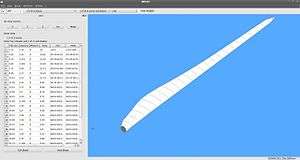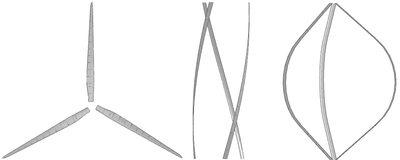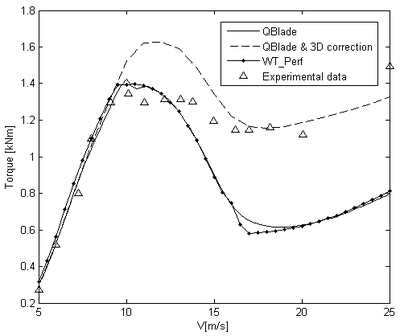QBlade
QBlade is an open-source, cross-platform simulation software for wind turbine blade design and aerodynamic simulation.[1] It comes with a user-friendly graphical user interface (GUI) based on Qt.
 | |
 A screenshot of QBlade | |
| Original author(s) | TU Berlin |
|---|---|
| Developer(s) | Open-source community |
| Stable release | 0.96.3
/ September 21, 2016 |
| Operating system | Linux, Windows |
| Available in | English |
| Type | Wind energy software |
| License | GPL |
| Website | q-blade sourceforge |
Overview
QBlade is an open-source wind turbine calculation software, distributed under the GNU General Public License. The software is seamlessly integrated into XFOIL, an airfoil design and analysis tool. The purpose of this software is the design and aerodynamic simulation of wind turbine blades. The integration in XFOIL allows for the user to rapidly design custom airfoils and compute their performance curves, Extrapolating the performance data to a range of 360°Angle of attack, and directly integrate them into a wind turbine rotor simulation. The integration of QBlade into XFLR's sophisticated graphical user interface makes this software accessible to a large potential user community.
QBlade is especially adequate for teaching, as it provides a ’hands-on’ feeling for HAWT rotor design and shows all the fundamental relationships between blade twist, blade chord, section airfoil performance, turbine control, power and load curves in an easy and intuitive way. QBlade also includes post processing of conducted rotor simulations and gives deep insight into all relevant blade and rotor variables.
Development History
QBlade's development started in 2009 as a small part of the PhD work of G. Pechlivanoglou at the Hermann Föttinger Institute of TU Berlin. The initial development was done by D. Marten, at the time an undergraduate student of Physical Engineering. Prof. C.O. Paschereit, head of the Hermann Föttinger Institute was a strong proponent of the idea to release QBlade under GPL and thus the software was quickly hosted on the official site of the institute. The 1st online version was received with positive remarks which led to the continuation of the development. G. Weinzierl, undergraduate student at the time initiated the development of an integrated turbulent wind field generator, while J. Wendler under the supervision of D. Marten developed the VAWT module as well as the Viterna 360° extrapolation module. M. Lennie, performed the development of a structural Euler-Bernoulli beam module (QFEM). N. Moesus further developed and integrated the code of G. Weinzierl and M. Lennie in the QBlade code. Furthermore, he initiated the integration of a fully developed (GUI) for the aeroelastic code FAST inside QBlade. The completion of the integration of all the aforementioned modules in QBlade is handled by J.Wendler, N. Moesus and D. Marten and the updated version (v0.8) of the software was released on the 9th of May 2014.
An updated stable version was released in August 2015. This included a new aerodynamic module which replaced the BEM of QBlade with a new advanced Lifting Line Theory (LLT) module. Furthermore, a Free Wake Vortex model was implemented for the accurate representation of the near and far wake of the turbine. The entire development of this version was undertaken by D. Marten.
Current development focuses on the expansion of both the dynamic and the aerodynamic capabilities of the software as well as its export/import interface. D. Marten is the person mainly responsible for the development and supervision of future versions while G. Pechlivanoglou, J. Saverin, N. Moesus and J. Wendler are currently active in the project.
Functionality
The functionality of QBlade includes the following features:
- Extrapolation of XFOIL generated or imported polar data to 360° Angle of attack.
- Blade design and optimization, including 3D visualization, using XFOIL generated or imported airfoil.
- Wind turbine definition (rotor blade, turbine control, generator type, losses...).
- Computation of rotor performance over Tip speed ratio (tip speed ratio) range.
- Multi parameter rotor simulations.
- Turbulent inflow field generator according to the model of Veers.[2]
- Integration of aeroelastic code AeroDyn/FAST of the National Renewable Energy Laboratory (NREL).[3][4]
- Computation of turbine performance over a wind speed range.
- Annual energy yield computation based on a Weibull distribution of wind speeds.
- Manual selection of Blade element theory correction algorithms.
- Access to all simulation parameters for flexible use.
- Data post processing and visualization (dynamic graphs).
- Export functionality for all simulation data.
- Blade geometry export functionality.
- Storing of projects, rotors, turbines and simulations in a runtime database.
- Lifting Line Theory (LLT) aerodynamic module
- Free Wake Vortex Model
- Multi-thread capability
- Advanced project & blade import and export functionality
- Integration of sample test projects including the popular NREL 5MW blade design

New in 0.95
-Added unsteady aerodynamics model with Beddoes-Leishman type dynamic stall model
-All project files have been updated to include decomposed polars for the UA model
-Added multi (Reynolds number) polar blade definition in the blade design module
-Added polar preprocessor for dynamic stall simulations
-Added PNoise module for airfoil self-noise evaluation
-Added floating platform turbine simulations through *.sim files
-Binary windfield files (*.bts) can now be imported through the “Windfield” menu
-Added turbine startup simulations, including adaptive time stepping
-Added ParaView export functionality for velocity fields
-Added vortex centered & higher order velocity integration scheme for improved stability
-Added graph menu to choose number and arrangement of graphs
-Added VAWT blade design: “pitch axis” for blade sections has been added as a design parameter
-Added HAWT blade design: Added Z-Offset parameter to advanced design for pre-bend blades
-Added 3D correction for the Himmelskamp effect to LLFVW HAWT simulations
-Added position of bound vortex and evaluation point for AoA's to LLFVW simulation parameters
-Added estimates for vortex induced velocities to LLFVW simulation dialog
-Added .stl and .txt geometry export functionality for VAWT blades
-Added dialog to change graph arrangements
-Several improvements of overall stability, GUI and numerous bug fixes
v0.96.3 includes a hotfix for a problem leading to crashes during polar extrapolation!
License
QBlade is distributed under the GPL license. It is maintained and continuously developed by the Hermann Föttinger Institute of TU Berlin (Chair of Fluid Dynamics).
Validation
QBlade has been successfully validated against the WT_Perf Blade Element Momentum Theory code of NWTC. Furthermore, it showed good agreement with the experimental performance data measured at the NASA Ames Research Center wind tunnel during the National Renewable Energy Laboratory 10m Wind Turbine Testing campaign[5]

See also
References
- D. Marten, et al., "QBlade: An open source tool for design and simulation of horizontal and vertical axis wind turbines," International Journal of Emerging Technology and Advanced Engineering (IJETAE) 3.3 (2013): 264-269, March 2013. Available here. Accessed 16 August 2017/
- http://prod.sandia.gov/techlib/access-control.cgi/1988/880152.pdf
- GL Wind Certificate No. ZZ 001A-2005 Archived February 22, 2013, at the Wayback Machine
- NWTC Design Codes
- "Archived copy". Archived from the original on April 25, 2011. Retrieved May 28, 2011.CS1 maint: archived copy as title (link), NREL 10-m Wind Turbine Testing in NASA Ames 80'x120' Wind Tunnel.
Further reading
- Marten, D.; Pechlivanoglou G.; Nayeri C.N.; Paschereit C.O. (November 2010). "INTEGRATION OF A WT BLADE DESIGN TOOL IN XFOIL/XFLR5". DEWEK Proceedings.
- Hansen, Martin O. (2007). Aerodynamics of Wind Turbines. Earthscan. p. 208. ISBN 978-1-84407-438-9.
- "Turbine Specifications for Model Construction" (PDF). NREL. Retrieved 28 May 2011.
External links
| Wikimedia Commons has media related to QBlade. |